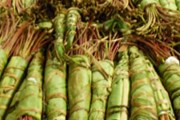
BY: JOEL HENDON
According to a CBP press release dated Dec. 28, 2012, the U.S. Customs and Border Protection officers seized over 213 pounds of khat that was shipped as air freight from Doha, Qatar to Washington Dulles International Airport.
It is the second largest khat seizure recorded by the CBP. Second only in air cargo at Dulles since April 30, 2010, when CBP officers seized 385 pounds of the amphetamine-like plant. CBP officers discovered the 96.92 kilograms, or 213 pounds, 10.7 ounces, of khat (pronounced COT) during a routine inspection of freight manifested as wood coffee tables. The khat has an approximate street value of about $30,000.
Khat is a green, leafy plant grown in the Arabian Peninsula. Its principal components, cathine and cathinone, are considered controlled substances in the United States. The Drug Enforcement Administration classifies khat as a schedule 1 narcotic – the most restrictive category used by the DEA – when the leaves are freshly picked. It is chewed for its stimulant effect and retains its potency for up to 48 hours after being harvested. The World Health Organization classified khat as a drug of abuse in 1980.
Catha edulis, commonly called Arabian tea, khat, qat, gat, or miraa, is a flowering plant native to the Horn of Africa and the Arabian Peninsula. Among communities from these areas, khat chewing has a long history as a social custom dating back thousands of years.
“Khat remains an illegal substance in the United States and as such, Customs and Border Protection officers remain vigilant to intercept khat and other illicit and dangerous drugs at our nation’s borders,” said Christopher Hess, CBP port director for the Port of Wash., D.C. “Narcotics interdiction remains a CBP enforcement priority.” (Ibid)
The freight was being shipped from a wood working company in Kenya to a furniture store in Wash., D.C. Prosecution was declined. CBP officers seized and destroyed the khat.
Khat contains a monoamine alkaloid called cathinone, an amphetamine-like stimulant, which is said to cause excitement, loss of appetite and euphoria. In 1980, the World Health Organization (WHO) classified it as a drug of abuse that can produce mild to moderate psychological dependence (less than tobacco or alcohol), although the WHO does not consider khat to be seriously addictive. The plant has been targeted by anti-drug organizations like the DEA. It is a controlled or illegal substance in some countries, such as the United States, Canada and Germany, while its production, sale and consumption are legal in other nations, including Djibouti, Ethiopia, Somalia and Yemen.

No comments:
Post a Comment